Intel’s Sandy Bridge i7-2820QM: Upheaval in the Mobile Landscape
by Jarred Walton on January 3, 2011 12:00 AM EST- Posted in
- Laptops
- Intel
- Sandy Bridge
- Compal
Mobile Sandy Bridge Application Performance
We’ll start off with a bang and show application performance, along with media encoding performance comparing Intel’s QuickSync technology with CUDA video encoding. We’ve got a variety of laptops and notebooks in our charts for comparison, including dual-core and quad-core AMD (not their fastest mobile chips, unfortunately), plenty of Arrandale options, and a few Clarksfield notebooks as well. And just for good measure, we’ve included results from a desktop Core i7-920 as a point of comparison. Normally that would be raining on Intel’s parade by showing how previous generation desktop hardware is still quite a bit faster; this time, however… well, I’ll let the charts tell the story.
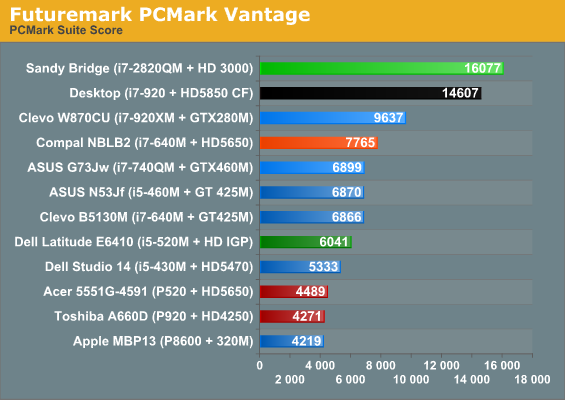
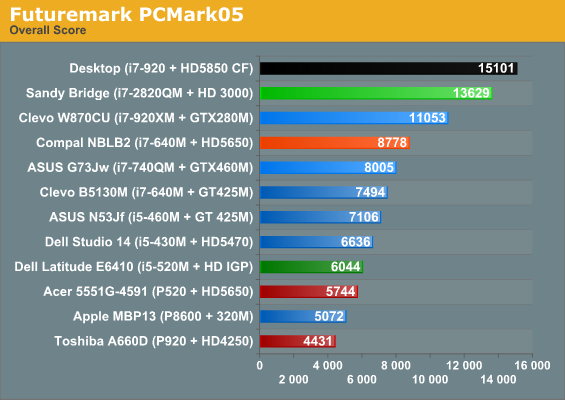
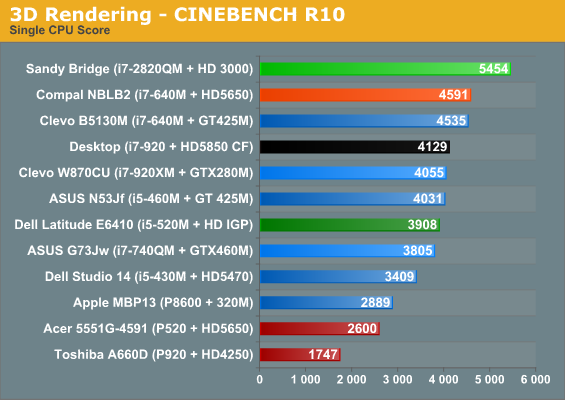
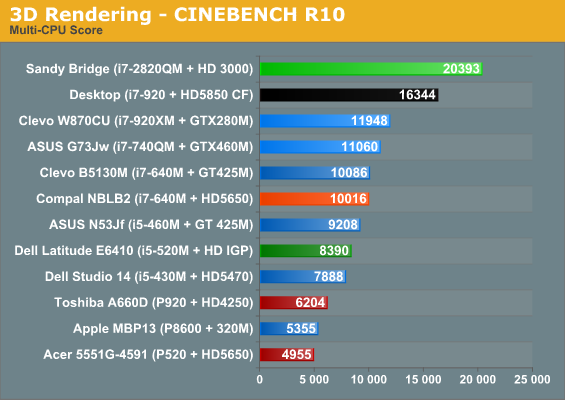
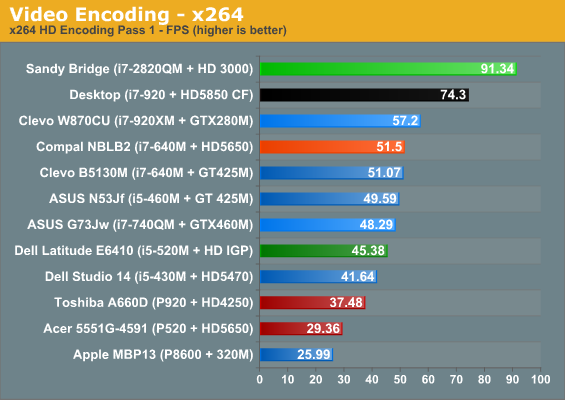

So, is anyone as impressed as I am? Sure, hex-core Gulftown is still the fastest game in town, and the desktop Sandy Bridge chips are obviously going to beat the mobile chips, but check out the scores relative to the i7-920 in my own “for play” system. (Incidentally, my “for work” system is actually running QX6700 still, and it does even worse! But all I do there is type documents and surf the web.) Let’s talk percentages here just to put it all into perspective.
Since PCMark Vantage and 05 are susceptible to heavy SSD influence, we’ll just skip those scores; suffice it to say that Sandy Bridge is no slouch there. Turn to CPU-intensive benchmarks, however, and we can really see the changes. Starting with single-threaded Cinebench, the new i7-2820QM checks in 35% faster than the outgoing i7-920XM, 32% faster than a desktop i7-920, 43% faster than the i7-740QM, and 19% faster than the previous generation’s fastest dual-core part.
Use applications that are thread-friendly and the gap widens even more. In Cinebench SMP, the closest competitor in our charts is the desktop i7-920, and 2820QM maintains a healthy 23% lead—in fact, looking at our desktop reviews, the stock (but with Turbo) 2820QM is roughly equal to an i7-930 overclocked to 3.5GHz. It also leads the i7-920XM by 84%, and an i7-640M by 104% (!). x264 encoding tells a similar story: the second pass is 9% faster than i7-920 desktop, 65% faster than i7-920XM, and twice as fast as i7-640M—and that’s without using the new QuickSync technology! [Whoa, nice segue Batman!]










66 Comments
View All Comments
JarredWalton - Tuesday, January 4, 2011 - link
Definitely a driver bug, and I've passed it along to Intel. The HD 4250 manages 7.7FPS, so SNB ought to be able to get at least 15FPS or so. The game is still a beast, though... some would say poorly written, probably, but I just call it "demanding". LOLsemo - Monday, January 3, 2011 - link
Thanks for mentioning USB 3.0 Jarred. It is a much too overlooked essential feature these days. I simply will not pay money for a new laptop in 2011 without a single USB 3.0 port.dmbfeg2 - Monday, January 3, 2011 - link
Which tool do you use to check the turbo frequencies under load?JarredWalton - Monday, January 3, 2011 - link
I had both CPU-Z and the Intel Turbo Monitoring tool up, but neither one supports logging so I have to just eyeball it. The clocks in CPU-Z were generally steady, though it's possible that they would bump up for a few milliseconds and then back down and it simply didn't show up.Shadowmaster625 - Monday, January 3, 2011 - link
On the other Sandy Bridge article by Anand, right on the front page, it is mentioned that the 6EU GT1 (HD2000) die has 504M transistors, while the 12EU GT2 (HD 3000) die has 624M transistors. Yet here you are saying HD Graphics 3000 has 114M. If the 12EU version has 120M more transistors than the 6EU version, then does that not imply a total gpu transistor count well north of 200M?JarredWalton - Monday, January 3, 2011 - link
AFAIK, the 114M figure is for the 12EU core. All of the currently shipping SNB chips are quad-core with the full 12EU on the die, but on certain desktop models Intel disables half the EUs. However, if memory serves there are actually three SNB die coming out. At the top is the full quad-core chip. Whether you have 6EU or 12EU, the die is the same. For the dual-core parts, however, there are two chips. One is a dual-core with 4MB L3 cache and 12EUs, which will also ship in chips where the L3 only shows 3MB. This is the GT1 variant. The other dual-core version is for the ultra-low-cost Pentium brand, which will ship with 6EUs (there will only be 6EU on the die) and no L3 cache, as well as some other missing features (Quick Sync for sure). That's the GT2, and so the missing 120M includes a lot of items.Note: I might not be 100% correct on this, so I'm going to email Anand and our Intel contact for verification.
mino - Monday, January 3, 2011 - link
Nice summary (why was this not in the article ?).Anyway those 114M do not include memory controller, encoding, display output etc. so the comparison with Redwood/Cedar is not really meaningful.
If you actually insist on comparing transistor counts, semething like (Cedar-Redwood)/3 shall give you a reasonable value of AMD's SPU efficiency from transistors/performance POW.
mino - Monday, January 3, 2011 - link
"After all, being able to run a game at all is the first consideration; making it look good is merely the icing on the cake."If making it look good is merely icing on the cake, why bother with GPUs ? Lets just play 2D Mines!
(While for the poor souls stuck with Intel IGPs it certainly is just the icing, for Christ's sake, that is a major _problem_, not a feature !!!)
After a few pages I have decided to forgo the "best-thing-since-sliced-bread" attitude, but, what is too much is too much...
mino - Monday, January 3, 2011 - link
Regardless the attitude, HUGE thanks for listening to comments and including the older games roundup.While I'd love to see more games that actually provide playable frame-rates (read: even older ones) on SNB-class IGPs like Far Cry or HL2, even this mini-roundup is a really big plus.
As for a suggestion on future game-playability roundup on IGP's, it is really simple:
1) Take a look at your 2006-2007 GPU benchmarking suites
2) Add in a few current MMORPGs
JarredWalton - Monday, January 3, 2011 - link
Anand covered several other titles, and most of the pre-2007 stuff should run fine (outside of blacklisting problems or bugs). Time constraints limit how much we can test, obviously, but your "reviewer on crack" comment is appreciated. 2D and 3D are completely different, and while you might feel graphical quality is of paramount importance, the fact of the matter is that SNB graphics are basically at the same level as PS3/Xbox 360 -- something millions of users are "okay" with.NVIDIA and AMD like to show performance at settings where they're barely playable and SNB fails, but that's no better. If "High + 1680x1050" runs at 20FPS with Sandy Bridge vs. 40FPS on discrete mobile GPUs, wouldn't you consider turning down the detail to get performance up? I know I would, and it's the same reason I almost never enable anti-aliasing on laptops: they can't handle it. But if that's what you require, by all means go out and buy more expensive laptops; we certainly don't recommend SNB graphics as the solution for everyone.
Honestly, until AMD gets the Radeon equivalent of Optimus for their GPUs (meaning, AMD GPU + Intel CPU with IGP and automatic switching, plus the ability to update your Radeon and Intel drivers independently), Sandy Bridge + GeForce 400M/500M Optimus is going to be the way to go.